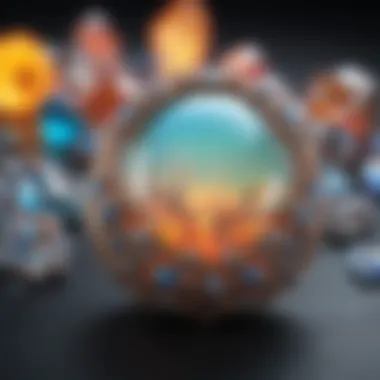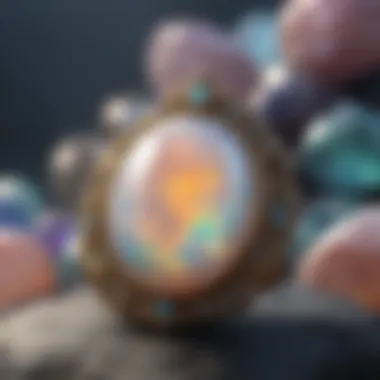Unveiling the Magnificence of Opal Stones: A Comprehensive Guide to Jewelry Making


Overview of Gemstones and Minerals
Gemstones and minerals have a rich history dating back centuries, weaving through various cultures and societies globally. The allure of these natural treasures transcends mere aesthetics, delving deeper into symbolism, spirituality, and tradition. From ancient times to modern civilizations, gemstones and minerals have held a significant place in our lives, symbolizing status, protection, and even healing properties. The mystique surrounding these precious stones continues to captivate gemstone enthusiasts, collectors, and jewelry designers alike.
Gemstone Formation and Properties
The formation of gemstones is a fascinating process that unfolds over millions of years deep within the Earth's crust. Through a combination of heat, pressure, and mineral crystallization, ordinary rocks evolve into exquisite gemstones, each with its unique characteristics and allure. Gemstones are defined by a range of properties, including color, clarity, cut, and carat weight, that collectively determine their beauty and value. These properties, along with hardness and luster, showcase the diversity and complexity of gemstones, making them a subject of fascination for geology enthusiasts and collectors.
Types of Gemstones
The world of gemstones is vast and diverse, encompassing both precious and semi-precious varieties that span a spectrum of hues and textures. Precious gemstones like diamonds, rubies, sapphires, and emeralds are revered for their rarity, durability, and brilliance, commanding attention and admiration in the world of jewelry making. In contrast, semi-precious gemstones offer a wide array of colors and prices, making them accessible to a broader audience of gemstone enthusiasts and collectors. Exotic and rare gemstones further add intrigue to this world of natural wonders, captivating the imagination with their scarcity and unique beauty.
Identifying and Evaluating Gemstones
The value of a gemstone is influenced by various factors, including its rarity, color intensity, size, and clarity. Gemstone identification requires a keen eye and specialized knowledge, as differentiating between natural and synthetic stones can be a challenging task. Gemologists use advanced techniques such as spectroscopy, microscopy, and polarizing filters to assess gemstone quality accurately, ensuring transparency and authenticity in the gemstone market. Assessing gemstone quality involves evaluating the \
Introduction to Opal Stones
Opal stones hold a profound significance in the realm of gemology and jewelry making. Their unique formation process and mesmerizing color play make them a highly sought-after gemstone in the industry. Opals are revered for their enchanting appearance and symbolic meanings, making them a popular choice for jewelry designers looking to create unique and visually stunning pieces. Understanding the origins and properties of opal stones is essential for gemstone enthusiasts, jewelry designers, and consumers alike, as it allows for a deeper appreciation of the beauty and allure of these captivating gems.
Origins and Formation of Opal Stones
The Geological Processes Behind Opal Formation
Opal formation is a fascinating natural phenomenon that involves the interaction of silica-rich water with host rocks. This process occurs over millions of years, during which silica deposits create the intricate play-of-color that opals are renowned for. The geological forces behind opal formation contribute to the gem's unique characteristics, such as its iridescence and color range. This geological process is crucial to the overall beauty and value of opal gemstones, making them a prized possession for collectors and enthusiasts.
Factors Influencing the Color Play in Opals


The mesmerizing color play in opals is influenced by various factors, including the size and alignment of silica spheres within the gemstone. These microscopic structures diffract light, creating the vibrant spectral colors that opals are known for. Environmental conditions during the formation of opal also impact its color play, resulting in a diverse range of hues and patterns. Understanding the factors that influence color play in opals is essential for assessing the quality and value of these gemstones, guiding both buyers and sellers in the market.
Types and Varieties of Opal Gemstones
Common Types: Black, White, Fire, and Boulder Opals
Opals exhibit a wide range of varieties, with common types including black, white, fire, and boulder opals. Each type possesses unique characteristics that set them apart, from the deep, rich colors of black opals to the luminous play-of-color in fire opals. Jewelry designers often gravitate towards these common opal types for their versatility and visual impact, allowing for creative expression in various designs.
Rare and Exotic Varieties: Crystal Opal, Harlequin Opal
In addition to the common types, rare and exotic opal varieties such as crystal opal and harlequin opal are treasured for their exceptional beauty and scarcity. Crystal opals boast a transparent body that enhances their color play, while harlequin opals feature a distinct pattern resembling a checkerboard. These rare opal varieties are highly sought after by collectors and connoisseurs for their rarity and unique visual appeal, making them prized possessions in the world of gemstone artistry.
Properties and Characteristics of Opals
Play-of-Color: The Mesmerizng Visual Effect
A defining feature of opal gemstones is their play-of-color, a captivating visual effect that results from light diffraction within the silica spheres of the gem. This optical phenomenon imparts a dynamic and ever-changing display of colors, giving each opal its signature iridescence. The play-of-color is a highly desirable trait in opals, elevating their aesthetic value and making them a popular choice for vibrant and alluring jewelry pieces.
Transparency, Hardness, and Durability
Apart from their color play, opals exhibit varying degrees of transparency, hardness, and durability depending on the type and variety. While some opals may possess a high level of transparency, others lean towards opacity, each offering distinct aesthetic qualities for jewelry making. Understanding the transparency, hardness, and durability of opals is essential for selecting the right gemstone for specific jewelry designs, ensuring both visual appeal and long-lasting quality in the finished piece.
Opals in Jewelry Making
Opals hold a significant place in the realm of jewelry making, offering a unique charm that appeals to gemstone connoisseurs and designers alike. The versatility and captivating play-of-color seen in opals make them a popular choice for creating exquisite jewelry pieces. Understanding the intricate nuances of opals in jewelry making is crucial for harnessing their beauty to its fullest potential, whether as centerpiece stones or in combination with precious metals.
Design Inspirations and Trends


Opal as a Centerpiece Gemstone
Opal as a centerpiece gemstone exudes a distinct allure due to its mesmerizing play-of-color, creating a focal point that captures attention effortlessly. The iridescent hues and patterns seen in opals lend a sense of dynamism to any jewelry piece, making it a versatile and visually striking choice. Designers often choose opals as centerpieces to add a pop of color and a touch of mystique to their creations. While opals showcase remarkable beauty, their delicate nature necessitates careful handling and setting techniques to preserve their radiance.
Pairing Opals with Precious Metals
Pairing opals with precious metals such as gold or silver creates a harmonious contrast that accentuates the opal's intrinsic beauty. The soft sheen of metals complements the iridescence of opals, adding a touch of elegance and sophistication to the overall design. This pairing allows for the creation of versatile jewelry pieces that can transition seamlessly from day to night, catering to varying style preferences. When choosing to pair opals with precious metals, consider the color play of the opal and how it meshes with the metal to achieve a cohesive and visually appealing composition.
Setting Styles and Techniques for Opal Jewelry
Bezel, Prong, and Tension Settings
The choice of setting styles significantly impacts the overall aesthetic and durability of opal jewelry pieces. Bezel, prong, and tension settings are popular options for securing opals in place while allowing maximum light exposure to enhance their play-of-color. Bezel settings provide a protective and secure housing for opals, reducing the risk of damage from external factors. Prong settings, on the other hand, elevate opals above the metal, enabling light to pass through the gemstone for enhanced brilliance. Tension settings offer a modern and sleek look, holding the opal in place with minimal visible metal, emphasizing the gemstone's beauty.
Incorporating Opal Doublets and Triplets
Incorporating opal doublets and triplets involves combining opal slices with other materials to enhance their durability and visual appeal. Doublets consist of a thin slice of opal bonded to a dark backing, intensifying the play-of-color and providing added protection. Triplets feature a transparent quartz capping, magnifying the opal's colors while safeguarding it from wear and tear. By utilizing doublets and triplets, designers can create captivating opal jewelry pieces that withstand daily wear and maintain their exquisiteness over time.
Caring for Opal Jewelry
Cleaning and Maintenance Tips
Proper cleaning and maintenance are paramount for preserving the beauty and longevity of opal jewelry. Gently clean opals with a soft, damp cloth to remove dirt and debris, avoiding harsh chemicals that can harm the gemstone's delicate surface. Periodic professional cleaning ensures thorough maintenance and inspection of settings to prevent any potential damage. Storing opal jewelry away from direct sunlight and extreme temperatures safeguards against color fading and structural weakening, prolonging the vibrancy of the gemstone.
Protecting Opals from External Factors
Shielding opals from external factors such as chemicals, oils, and sharp blows is essential in maintaining their luster. Avoid exposing opal jewelry to household cleaners, perfumes, or lotions as these substances can cause discoloration or erosion of the gemstone. When not in use, store opal pieces separately to prevent scratches and impacts that can compromise their integrity. By taking proactive measures to protect opals from external influences, you can ensure their timeless beauty endures for generations to come.


Opal Stones Beyond Jewelry
Opal Stones Beyond Jewelry explores the diverse applications of opal gemstones beyond their traditional use in jewelry making. This section delves into the broader significance of opals in various contexts, shedding light on their cultural, symbolic, and investment value. Understanding Opal Stones Beyond Jewelry is crucial for gemstone enthusiasts, collectors, and investors seeking to appreciate opals beyond their ornamental role. From symbolism to healing properties, opals offer a multifaceted appeal that goes well beyond their aesthetic allure. Exploring these different facets enriches one's perception of opals and their place in the gemstone world.
Symbolism and Cultural Significance
Opal in Folklore and Mythology
Opal in Folklore and Mythology holds a prominent place due to its intriguing history and symbolic meanings. In various cultures, opals have been associated with luck, love, and purity. The play of color within opals was often linked to supernatural powers and mystical qualities in ancient beliefs. Opal in Folklore and Mythology enriches our understanding of how gemstones have been revered and imbued with special significance throughout history. This exploration reveals the enduring appeal of opals across different civilizations and their enduring legacy in storytelling and tradition.
Modern Interpretations and Beliefs
Modern Interpretations and Beliefs surrounding opals offer a fresh perspective on how these gemstones are perceived and utilized in contemporary society. Opals are not just beautiful adornments but are also seen as symbols of creativity, inspiration, and emotional healing. The modern interpretation of opals emphasizes their unique play of color as a reflection of individuality and inner beauty. Incorporating opals in modern designs showcases their continuing relevance and timeless charm, capturing the essence of elegance and sophistication in jewelry pieces.
Healing Properties and Metaphysical Uses
Emotional Healing and Energy Balancing
Emotional Healing and Energy Balancing with opals are believed to promote emotional resilience and harmonize one's energy flow. Opals are thought to offer comfort during times of stress and anxiety, fostering a sense of calm and balance. Their soothing energy is said to activate the heart chakra, encouraging emotional healing and self-acceptance. Exploring Emotional Healing and Energy Balancing with opals reveals their holistic benefits beyond their visual appeal, making them a popular choice for individuals seeking inner peace and spiritual growth.
Spiritual Connection and Chakra Alignment
Spiritual Connection and Chakra Alignment through opals delve into their metaphysical properties that are thought to align with spiritual energies. Opals are believed to open channels of communication with higher realms and enhance spiritual awareness. By activating the crown chakra, opals are said to facilitate spiritual growth and enlightenment. Their ethereal beauty and energetic vibrations resonate with individuals seeking to deepen their spiritual connections and elevate their consciousness.
Collecting and Investing in Opal Gemstones
Factors Influencing Opal Value
Factors Influencing Opal Value play a significant role in the gemstone market, affecting their rarity and desirability. Opals are valued based on factors such as color intensity, play-of-color patterns, clarity, and origin. Understanding these criteria helps collectors and investors assess the quality and worth of opals in their collection. Factors Influencing Opal Value guide enthusiasts in making informed decisions when acquiring opals, ensuring they invest in stones of high value and aesthetic appeal.
Trends in Opal Market
Trends in Opal Market reflect the evolving preferences and demands within the gemstone industry, influencing opal prices and market dynamics. Keeping abreast of trends in opal procurement, design, and consumer preferences is vital for both buyers and sellers in the gem trade. By staying informed about the latest market trends, collectors, designers, and investors can position themselves advantageously in the competitive opal market, ensuring the longevity and profitability of their opal investments.







